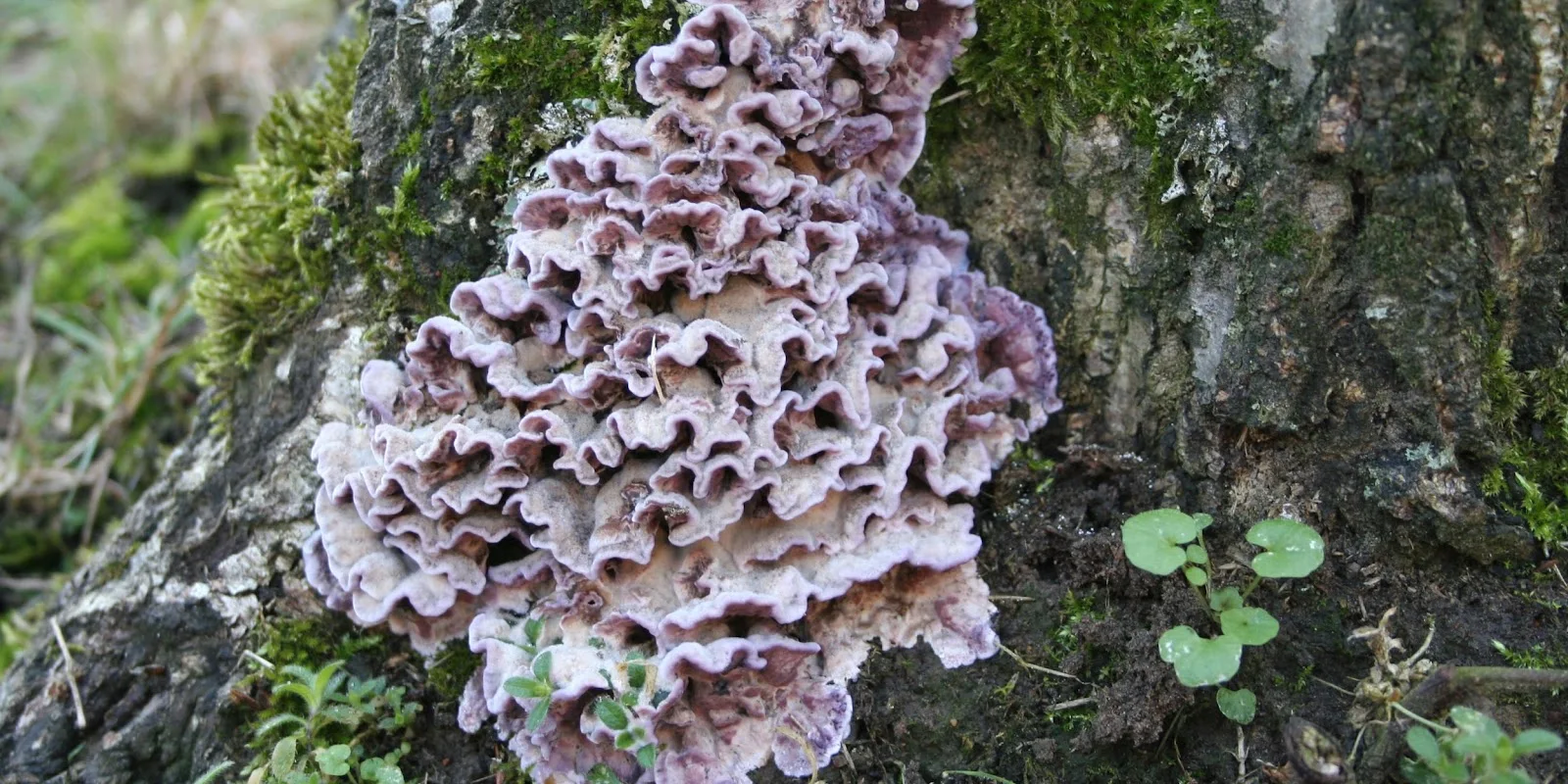Whats is the Rose-Killing Fungus: Chondrostereum Purpureum, aka silverleaf fungus
Chondrostereum purpureum, commonly known as the silverleaf fungus, is a fascinating organism that has captured the interest of mycologists and researchers alike. This fungus, known for its unique purple hue, is found primarily in the Northern Hemisphere and has a range of ecological impacts. This essay delves into the biology of Chondrostereum purpureum, its ecological roles, and recent news about this captivating fungus.
Why is it called the Rose Killing Fungus
This nickname is given due to its ability to infect and cause dieback in various woody plant species, including rose bushes (Rosa spp.). The fungus can invade wounded or damaged plant tissue, such as pruning cuts or natural openings, and subsequently colonize the host's vascular system. This colonization can lead to the death of affected branches or, in severe cases, the entire plant.
The common name "rose killing fungus" likely stems from the fungus's impact on cultivated roses, which are popular ornamental plants in gardens and landscapes. Infections caused by C. purpureum can have detrimental effects on the health and appearance of roses, making the fungus a significant concern for rose growers and gardeners. However, it is essential to note that roses are not the only species affected by this fungus; it can infect a wide range of deciduous trees and shrubs, including fruit trees in the Prunus genus, which makes it a more widespread concern for horticulturists and arborists as well.
Biology of Chondrostereum purpureum
- Taxonomy and Morphology: Chondrostereum purpureum is a member of the Basidiomycota phylum, which encompasses a diverse group of fungi, including mushrooms, rusts, and smuts. It belongs to the family Stereaceae, which is characterized by fungi with crust-like or leathery fruiting bodies. The fruiting body of C. purpureum typically forms on dead or dying hardwood trees, appearing as a semicircular or fan-shaped structure with a vibrant purple color.
- Life Cycle and Reproduction: The life cycle of C. purpureum is heterothallic, which means it requires two genetically distinct mating types to reproduce. The fungus undergoes both sexual and asexual reproduction. Sexual reproduction involves the production of basidiospores, which are ejected from basidia (spore-producing cells) and dispersed by air currents. Asexual reproduction occurs through the formation of conidia, which are spores produced by mitosis.
- Ecological Niches and Distribution: C. purpureum is a saprobic fungus, meaning it decomposes dead organic matter, particularly wood. It plays a vital role in the natural decomposition process, breaking down complex lignin and cellulose structures into simpler compounds that can be utilized by other organisms. The fungus is commonly found in temperate regions of the Northern Hemisphere, including North America, Europe, and Asia, where it inhabits deciduous forests and woodlands.
The Role of Chondrostereum purpureum in Ecosystems
- Wood Decomposition and Nutrient Cycling: C. purpureum plays an essential role in wood decomposition and nutrient cycling within ecosystems. By breaking down dead wood, it releases essential nutrients such as nitrogen, phosphorus, and potassium back into the soil, contributing to nutrient cycling and overall ecosystem health. Additionally, the fungus provides habitat and resources for various insects and other small organisms.
- Biocontrol Agent: Chondrostereum purpureum has also garnered attention for its potential use as a biocontrol agent. It can effectively suppress the growth of other undesirable or invasive plants by infecting and killing them. In particular, the fungus has shown promise in controlling the growth of black cherry (Prunus serotina) and poplar (Populus spp.), which are known to be invasive species in certain regions.
Did a Human End Up Infected by This Rose-Killing Fungus?
In an article published by Medical Mycology Case Reports in March of 2023, but submitted in December of 2022, a male patient aged 61 from the eastern part of India visited the outpatient department due to various symptoms such as hoarseness of voice, cough, recurrent pharyngitis, fatigue, difficulty in swallowing, and anorexia that had persisted for three months. The patient had no history of any chronic illness or immunosuppressive drug intake. However, the patient's profession as a plant mycologist required him to work with decaying material, mushrooms, and various plant fungi as part of his research activities.
A CT scan of the neck revealed a right paratracheal abscess, which was treated with CT-guided aspiration. Although bacterial and mycobacterial growth was negative, fungal stain by Gomori's Methenamine Silver (GMS) showed the presence of septate hyphae. The fungus could not be identified phenotypically and was sent to a "WHO collaborating Centre for Reference and Research on Fungi of Medical importance" in India for identification, which confirmed it as Chondrostereum purpureum by DNA sequencing. According to the publication, this is a first of its kind of a case wherein this plant fungus caused disease in a human, a Zoonotic spillover.
Histopathological examination revealed mixed inflammatory cells and neutrophils, along with a few endobronchial cells on a necrohemorrhagic background. The patient was treated with complete drainage of the pus and oral voriconazole for 60 days, which resulted in the successful resolution of the infection.
This case highlights the fact that plant pathogens such as Chondrostereum purpureum can cause infections in healthy individuals, especially those who work with decaying plant material, and can establish themselves as human pathogens if they are able to evade the host immune system. It is important to identify the causative agent of any infection accurately to provide appropriate treatment.
What is a Zoonotic Spillover?
Zoonotic spillover refers to the transmission of infectious diseases from animals to humans. This can occur through direct contact with infected animals, consumption of contaminated animal products, or exposure to environmental reservoirs of the pathogen.
The term "zoonotic spillover" originates from the idea that pathogens that normally reside in animals can "spillover" into humans and cause disease. Zoonotic spillover is a natural phenomenon that has been occurring for centuries, but the increasing encroachment of humans into wildlife habitats and the growth of global trade and travel have increased the frequency and potential impact of zoonotic spillover events.
There are several ways in which zoonotic spillover can occur. One way is through direct contact with infected animals, such as hunting, handling, or consuming animal products. Another way is through exposure to environmental reservoirs of the pathogen, such as contaminated soil, water, or food. Some pathogens can also be transmitted through vectors such as mosquitoes, ticks, or fleas.
There have been several examples of zoonotic spillover events in the past, including:
- HIV/AIDS: The human immunodeficiency virus (HIV) is believed to have originated from a type of chimpanzee in Central Africa. The virus was transmitted to humans through the hunting and consumption of infected chimpanzees.
- Ebola: The Ebola virus is believed to have originated from bats in Africa. The virus was transmitted to humans through contact with infected animals or consumption of infected bushmeat.
- SARS: The severe acute respiratory syndrome (SARS) virus is believed to have originated from civet cats in China. The virus was transmitted to humans through the consumption of infected animals in live animal markets.
- COVID-19: The SARS-CoV-2 virus, which causes COVID-19, is believed to have originated from bats in China. The virus was transmitted to humans through an intermediate animal host, possibly a pangolin, in a live animal market.











